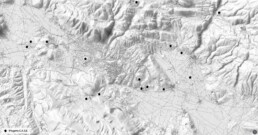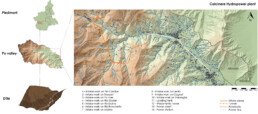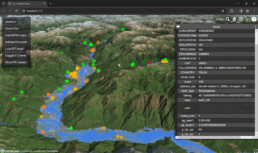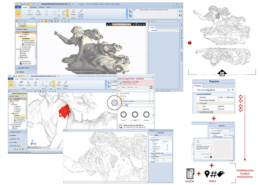Innovative strategies for planning the location of temporary dwellings in emergency situations.
ABSTRACT
The research illustrated in this paper aims to elaborate a method to identify, through algorithmic procedures, peri-urban areas in fragile contexts that have the correct characteristics to host temporary housing in case of both natural and anthropic disasters. These procedures are used in computer ecosystems dedicated explicitly to three-dimensional representation. The search for the areas themselves is guided and automated through optimisation algorithms that allow multiple variables to be considered and processed in the following definition of a wide range of results. The reduced timeframe for the design and realisation of these structures naturally leads towards the application of BIM methods for building definition. The case study to which the methodology mentioned earlier is applied is the area surrounding the historic centre of L’Aquila, a city hit in 2009 by seismic events that destroyed large portions of the territory.
Domenico D’Uva (1), Federico Eugeni (2)
1) Department of Architecture, Construction Engineering and the Built Environment, Politecnico di Milano,
2) Department of Civil, Construction and Environmental Engineering-Architecture, Università degli Studi dell’Aquila
BIM-GIS Integration. A review
ABSTRACT
The detailed visualisation of the project in the geographical context allows a greater understanding and evaluation of the impact and interconnections with the urban context. The contribution intends to highlight the state of the art and the results obtained in the integration of BIM and GIS.
Antonio Bocca, Antonio Maria Nese
Dd’A-Dipartimento di Architettura, Università degli Studi “G. d’Annunzio” Chieti-Pescara
Geospatial data and Visual Programming for BIM-GIS Modeling and management of Hydropower Infrastructure
ABSTRACT
In the complex infrastructure framework, BIM-GIS interoperability emerges as a critical knowledge factor, enabling multiscalar approaches and new potentials. A methodology for developing an integrated information model of an existing large hydroelectric derivation is framed.
Gianvito Marino Ventura, Francesca Maria Ugliotti, Anna Osello
Politecnico di Torino, Dipartimento di Ingegneria Strutturale, Edile e Geotecnica
BIM-GIS Integration for Risk Assessment of Built Heritage: Testing Recent Developments on Italian Public Buildings
ABSTRACT
The contribution proposes an approach to environmental risk assessment that integrates GIS and BIM data to carry out rapid analyses and detailed studies. The method identifies critical points and offers a basis for future mitigation strategies and informed urban planning.
Emmanuele Iacono, Francesca Maria Ugliotti, Anna Osello
Politecnico di Torino, Dipartimento di Ingegneria Strutturale, Edile e Geotecnica
Reviewer 2023
REVIEWER 2021
Pietro Baratono, Provveditore Interregionale per le OO.PP. Lombardia ed E.Romagna
Angelo Ciribini, Presidente ISTEA, Università di Brescia, Brescia, Italy
Bruno Daniotti, Project Manager InnovAnce, Politecnico di Milano, Milano, Italy
Alberto Pavan, Coordinatore norma UNI 11337, Responsabile Scientifico InnovAnce, Politecnico di Milano, Milano, Italy
Gregorio Cangialosi, BIM Manager and BIM Strategist, Studio CABE, Torino, Italy
Emmanuel di Giacomo, EMEA BIM & AEC Ecosystem Business, France
Graziano Lento, Anafyo Sagl, Ticino, Switzerland
Paolo Galli, Implementation Consultant BIM, Milano, Italy
Diego Minato, BIM Manager & Technical Consultant | BIM Strategist, Treviso, Italy
Orges Lesha, BIM Manager, SA Architects, Sdn Bhd, Kuala Lumpur, Malaysia
Chiara Rizzarda, Deputy BIM Manager at Antonio Citterio Patricia Viel, Milano, Italy
Yoseph Bausola Pagliero, VPL and BIM expert, Roma/ Torino, Italy
Armando Casella, Bimfactory, Brescia, Italy
Filippo Daniele, Setin Roma, Italy
Yusuf Arayici, Hasan Kalyoncu University, Gaziantep, Turkey
Maarten Bassier, University of Leuven, Leuven, Belgium
Stefano Bertocci, Università degli Studi di Firenze, Firenze, Italy
Carlo Bianchini, Sapienza Università di Roma, Roma, Italy
Maurizio Bocconcino, Politecnico di Torino, Torino, Italy
Frédéric Bosché, Heriot-Watt University, Edinburgh, United Kingdom
Stefano Brusaporci, Università degli Studi dell’Aquila, L’Aquila, Italy
Clark Cory, Purdue University, Indianapolis, USA
Livio De Luca, MAP/CNRS, Marseilles, France
Antonella Di Luggo, Università degli Studi di Napoli Federico II, Napoli, Italy
Stephen Fai, Carleton University, Ottawa, Canada
Pablo Lorenzo Eiroa, Cooper Union, New York, USA
Andrea Giordano, Università degli Studi di Padova, Padova, Italy
Antonio Gómez-Blanco Pontes, Universidad de Granada, Granada, Spain
Sorin Hermon, Cyprus Institute, Nicosia, Cyprus
Arto Kiviniemi, University of Liverpool , Liverpool, United Kingdom
Giovanna Massari, Università degli Studi di Trento, Trento, Italy
Maurice Murphy, Dublin Institute of Technology, Dublin, Ireland
Anna Osello, Politecnico di Torino, Torino, Italy
Livio Sacchi, Università degli Studi “G. d’Annunzio”, Chieti-Pescara, Italy
Andrew Sanders, Penn University, Philadelphia, USA
Alberto Sdegno, Università degli Studi di Trieste, Trieste, Italy
Jose Pedro Sousa, Universidade do Porto, Porto, Portugal
Massimo Stefani, Harpaceas
Anna Dell’Amico, Università degli Studi di Pavia, Pavia, Italy
Francesco Livio Rossini, Sapienza Università di Roma, Roma, Italy
Reviewer 2022
REVIEWER 2021
Pietro Baratono, Provveditore Interregionale per le OO.PP. Lombardia ed E.Romagna
Angelo Ciribini, Presidente ISTEA, Università di Brescia, Brescia, Italy
Bruno Daniotti, Project Manager InnovAnce, Politecnico di Milano, Milano, Italy
Alberto Pavan, Coordinatore norma UNI 11337, Responsabile Scientifico InnovAnce, Politecnico di Milano, Milano, Italy
Gregorio Cangialosi, BIM Manager and BIM Strategist, Studio CABE, Torino, Italy
Emmanuel di Giacomo, EMEA BIM & AEC Ecosystem Business, France
Graziano Lento, Anafyo Sagl, Ticino, Switzerland
Paolo Galli, Implementation Consultant BIM, Milano, Italy
Diego Minato, BIM Manager & Technical Consultant | BIM Strategist, Treviso, Italy
Orges Lesha, BIM Manager, SA Architects, Sdn Bhd, Kuala Lumpur, Malaysia
Chiara Rizzarda, Deputy BIM Manager at Antonio Citterio Patricia Viel, Milano, Italy
Yoseph Bausola Pagliero, VPL and BIM expert, Roma/ Torino, Italy
Armando Casella, Bimfactory, Brescia, Italy
Filippo Daniele, Setin Roma, Italy
Yusuf Arayici, Hasan Kalyoncu University, Gaziantep, Turkey
Maarten Bassier, University of Leuven, Leuven, Belgium
Stefano Bertocci, Università degli Studi di Firenze, Firenze, Italy
Carlo Bianchini, Sapienza Università di Roma, Roma, Italy
Maurizio Bocconcino, Politecnico di Torino, Torino, Italy
Frédéric Bosché, Heriot-Watt University, Edinburgh, United Kingdom
Stefano Brusaporci, Università degli Studi dell’Aquila, L’Aquila, Italy
Clark Cory, Purdue University, Indianapolis, USA
Livio De Luca, MAP/CNRS, Marseilles, France
Antonella Di Luggo, Università degli Studi di Napoli Federico II, Napoli, Italy
Stephen Fai, Carleton University, Ottawa, Canada
Pablo Lorenzo Eiroa, Cooper Union, New York, USA
Andrea Giordano, Università degli Studi di Padova, Padova, Italy
Antonio Gómez-Blanco Pontes, Universidad de Granada, Granada, Spain
Sorin Hermon, Cyprus Institute, Nicosia, Cyprus
Arto Kiviniemi, University of Liverpool , Liverpool, United Kingdom
Giovanna Massari, Università degli Studi di Trento, Trento, Italy
Maurice Murphy, Dublin Institute of Technology, Dublin, Ireland
Anna Osello, Politecnico di Torino, Torino, Italy
Livio Sacchi, Università degli Studi “G. d’Annunzio”, Chieti-Pescara, Italy
Andrew Sanders, Penn University, Philadelphia, USA
Alberto Sdegno, Università degli Studi di Trieste, Trieste, Italy
Jose Pedro Sousa, Universidade do Porto, Porto, Portugal
Massimo Stefani, Harpaceas
Anna Dell’Amico, Università degli Studi di Pavia, Pavia, Italy
Francesco Livio Rossini, Sapienza Università di Roma, Roma, Italy
Editorial Vol. 12
The information management of cultural heritage has become central in the field of research and public administration, as evidenced by the issues and calls of the PNNR on digital, enhancement and protection of cultural heritage. The twelfth issue of Dn brings together the best papers selected from those presented at the 3D Modeling and BIM conference held in Rome on 12 April 2023, organized by Sapienza University of Rome, on the theme “Solutions for Cultural Heritage”.
The selected contributions are original and exemplifying the innovations in the sector and the various experiments in progress. The H-BIM approach is transversal: from the urban scale to the archaeological and architectural-monumental scale up to the diagnostics of works of art.
In this direction, the contribution of Maria Grazia Cianci and Matteo Molinari experiments the adoption of the BIM methodology to historical architectures by choosing the western sector of the Baths of Diocletian in Rome as a field of investigation
On the other hand, the contribution of Pierpaolo D’Agostino and Giuseppe Antuono experiments with a multidisciplinary methodological protocol to structure a GIS/BIM management model for the public administration to support the process of acceptance-verification-issue of building permits, exploiting also the VPL to optimize information flows.
The contribution of Elisabetta Caterina Giovannini focuses on VPL approaches for the semi-automatic generation of H-BIM components, developing different solutions according to each VPL environment investigated.
The potential of the HBIM approach to support the planning, management, implementation and archiving of pre, during and post-restoration activities of works of art and decorative apparatuses is experienced in the contribution of Emanuela Lanzara and Simona Scandurra.
The creation of three-dimensional contents (replicas and new exhibition spaces) lends itself to the formulation of preliminary considerations in the contribution by Matteo Flavio Mancini and Laura Farroni on the adoption of the metaverse – an environment that arises without scientific purposes – for cultural heritage.
Finally, the issue is closed by the contribution of Camilla Tennenini, Lorenzo Gatto, Michele Calvano, Letizia Martinelli, Filippo Calcerano, Elena Gigliarelli who pay attention to the monumental asset and the computerized management of the results of the diagnostic investigations on the San Giovanni Monastery in Müstair.
In summary, these contributions demonstrate how theoretical research and practical applications are closely aligned, providing an important contribution to the development of communication, enhancement, conservation and recovery of cultural heritage. BIM is confirmed as a key tool in preserving and enhancing our cultural heritage, allowing new and innovative possibilities for understanding and using the history and art of the past.
Tommaso Empler, Cettina Santagati
Index Volume 12
INDEX
Editorial
T. Empler, C. Santagati
Building Information Modeling applied to archaeological structures: the case study of the western sector of the Baths of Diocletian
M. G. Cianci, M. Molinari
From building model to information management on an urban scale. An IFC-CityGML integration application
P. D’Agostino, G. Antuono
The semi-automatic generation of HBIM elements: VPL approaches compared
E. C. Giovannini
HBIM system for Restoration and Conservation of Artworks
E. Lanzara, S. Scandurra
Metaverse and Cultural Heritage: first Investigations between Potential and Criticality
M. F. Mancini, L. Farroni
HBIM for information management of diagnostics in conservation projects:
the case of the St. John Monastery in Müstair
C. Tennenini, L. Gatto, M. Calvano, L. Martinelli, F. Calcerano, E. Gigliarelli
Building Information Modeling applied to archaeological structures: the case study of the western sector of the Baths of Diocletian
ABSTRACT
The research investigates the theme of the analysis of BIM representation applied to cultural heritage. The objective of the research is to investigate, understand and experiment how a working methodology born for contemporary design can be transferred and adapted to work with historical architecture.
Maria Grazia Cianci, Matteo Molinari
Università degli Studi Roma Tre, Dipartimento di Architettura
From building model to information management on an urban scale. An IFC-CityGML integration application
ABSTRACT
The contribution aims to test a multidisciplinary methodological protocol to structure a GIS/BIM management model useful for the administrative decision-maker during the entire process of acceptance-verification-release of building permits.
Pierpaolo D’Agostino, Giuseppe Antuono
Dipartimento di Ingegneria Civile, Edile e Ambientale, Università degli Studi di Napoli Federico II







